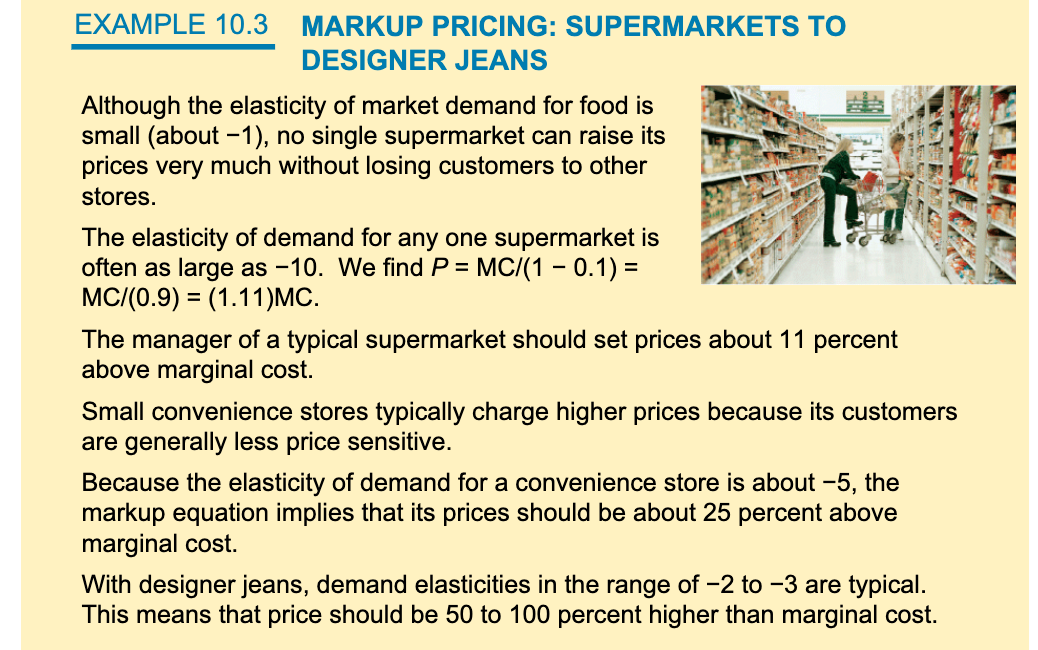Why do small convenience stores which are often open 24-7 typically charge higher prices than supermarkets? b. Why are designer label jeans typically more expensive than 'mass-market' jeans
Why do small convenience stores which are often open 24-7 typically charge higher prices than supermarkets? b. Why are designer label jeans typically more expensive than 'mass-market' jeans
Microeconomics: Private and Public Choice (MindTap Course List)
16th Edition
ISBN:9781305506893
Author:James D. Gwartney, Richard L. Stroup, Russell S. Sobel, David A. Macpherson
Publisher:James D. Gwartney, Richard L. Stroup, Russell S. Sobel, David A. Macpherson
Chapter7: Consumer Choice And Elasticity
Section: Chapter Questions
Problem 13CQ: Suppose Erin, the owner-manager of a local hotel projects the following demand for her rooms: a....
Related questions
Question
Refer to Example 10.3 - 'Markup Pricing: Supermarkets to Designer Jeans'
a. Why do small convenience stores which are often open 24-7 typically charge higher prices than supermarkets?
b. Why are designer label jeans typically more expensive than 'mass-market' jeans?

Transcribed Image Text:EXAMPLE 10.3
MARKUP PRICING: SUPERMARKETS TO
DESIGNER JEANS
Although the elasticity of market demand for food is
small (about -1), no single supermarket can raise its
prices very much without losing customers to other
stores.
The elasticity of demand for any one supermarket is
often as large as -10. We find P = MC/(1 - 0.1) =
MC/(0.9) = (1.11)MC.
%3D
The manager of a typical supermarket should set prices about 11 percent
above marginal cost.
Small convenience stores typically charge higher prices because its customers
are generally less price sensitive.
Because the elasticity of demand for a convenience store is about -5, the
markup equation implies that its prices should be about 25 percent above
marginal cost.
With designer jeans, demand elasticities in the range of -2 to -3 are typical.
This means that price should be 50 to 100 percent higher than marginal cost.
Expert Solution
This question has been solved!
Explore an expertly crafted, step-by-step solution for a thorough understanding of key concepts.
This is a popular solution!
Trending now
This is a popular solution!
Step by step
Solved in 2 steps

Knowledge Booster
Learn more about
Need a deep-dive on the concept behind this application? Look no further. Learn more about this topic, economics and related others by exploring similar questions and additional content below.Recommended textbooks for you

Microeconomics: Private and Public Choice (MindTa…
Economics
ISBN:
9781305506893
Author:
James D. Gwartney, Richard L. Stroup, Russell S. Sobel, David A. Macpherson
Publisher:
Cengage Learning

Economics: Private and Public Choice (MindTap Cou…
Economics
ISBN:
9781305506725
Author:
James D. Gwartney, Richard L. Stroup, Russell S. Sobel, David A. Macpherson
Publisher:
Cengage Learning

Managerial Economics: A Problem Solving Approach
Economics
ISBN:
9781337106665
Author:
Luke M. Froeb, Brian T. McCann, Michael R. Ward, Mike Shor
Publisher:
Cengage Learning

Microeconomics: Private and Public Choice (MindTa…
Economics
ISBN:
9781305506893
Author:
James D. Gwartney, Richard L. Stroup, Russell S. Sobel, David A. Macpherson
Publisher:
Cengage Learning

Economics: Private and Public Choice (MindTap Cou…
Economics
ISBN:
9781305506725
Author:
James D. Gwartney, Richard L. Stroup, Russell S. Sobel, David A. Macpherson
Publisher:
Cengage Learning

Managerial Economics: A Problem Solving Approach
Economics
ISBN:
9781337106665
Author:
Luke M. Froeb, Brian T. McCann, Michael R. Ward, Mike Shor
Publisher:
Cengage Learning


Managerial Economics: Applications, Strategies an…
Economics
ISBN:
9781305506381
Author:
James R. McGuigan, R. Charles Moyer, Frederick H.deB. Harris
Publisher:
Cengage Learning

Exploring Economics
Economics
ISBN:
9781544336329
Author:
Robert L. Sexton
Publisher:
SAGE Publications, Inc